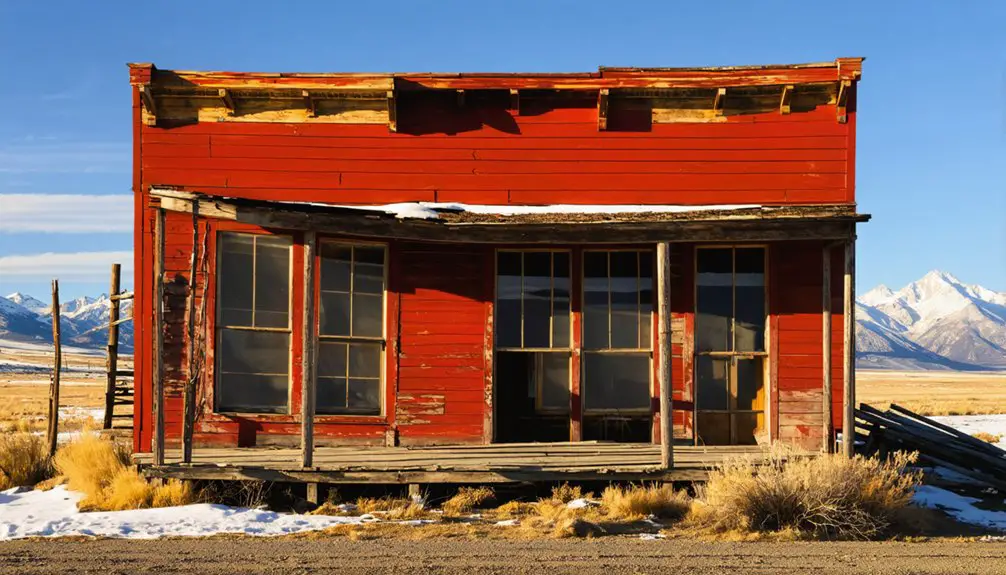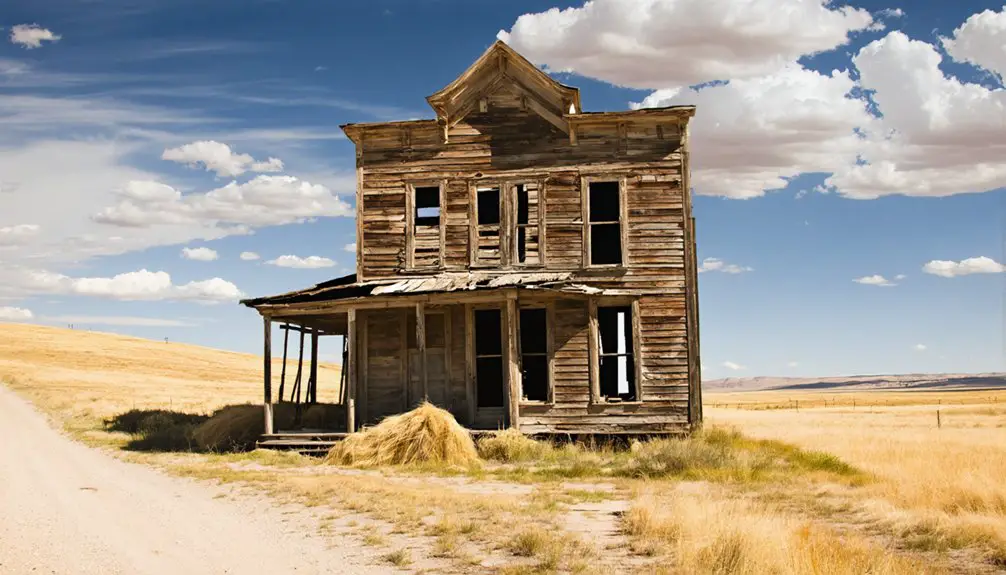In Old Upton, Wyoming, you’ll discover a meticulously preserved frontier settlement that nearly vanished in the 1890s. Originally called Iron City, then Merino, the town suffered a devastating fire that reduced its population to 200 residents. Burlington Railroad’s investment in water infrastructure and depot facilities transformed the struggling outpost into a crucial transportation hub. Today, you’ll find authentic pioneer structures, period artifacts, and the Red Onion Museum – tangible links to Wyoming’s railroad heritage that reveal an even richer frontier story.
Key Takeaways
- Old Upton narrowly escaped becoming a ghost town due to Burlington Railroad’s investment in infrastructure and water pipeline construction.
- After a devastating fire in 1890, the town’s population plummeted to 200 residents, and civic functions collapsed.
- The establishment of the Burlington Railroad depot in 1892 revitalized the town through job creation and population growth.
- Unlike typical ghost towns, Old Upton maintained its railroad connection and transformed into a meticulously restored historic site.
- The site now features pioneer structures, a Red Onion Museum, and preserved artifacts showcasing Wyoming’s frontier heritage.
From Iron City to Upton: The Story Behind the Name
While early settlers initially knew the settlement as Irontown or Iron City due to its proximity to Iron Creek in the late 1880s, the town’s name would evolve several times before becoming today’s Upton.
You’ll find historical significance in each name change, as they reflected the community’s shifting economic identity. When the settlement became a major sheep shipping point, it adopted the name Merino. The Chicago, Burlington & Quincy laid railroad tracks through the area in 1890, transforming the town into a vital transportation hub.
However, mail delivery confusion with another Colorado town called Merino forced another change. In 1901, the name evolution reached its final stage when the town was renamed Upton, honoring A. Z. “George” Upton, a railroad surveyor whose work helped establish the crucial Burlington Railroad connection that guaranteed the town’s survival. The town grew steadily after its founding, and by 1930, fourteen buildings lined the main street, including several bustling saloons.
Life on the Railroad: Burlington’s Impact on Growth
Burlington’s construction of a crucial water pipeline to Upton didn’t just serve steam locomotives – it transformed the settlement’s viability by providing essential infrastructure for the growing population.
You’ll find evidence of the railroad’s influence in the worker camps that sprung up, drawing laborers who established roots in the community despite initial population losses in 1893.
The railroad depot and station helped sustain the town through challenging times.
The railroad reached the area as part of CB&Q’s expansion strategy to transport Wyoming’s valuable timber, coal, and iron resources to eastern markets.
Water Pipeline Revolution
In an era when water scarcity threatened the survival of frontier settlements, the construction of Burlington Railroad’s water pipeline in Old Upton marked a revolutionary shift in Wyoming’s railroad town development.
You’ll find this water supply system wasn’t just a lifeline for steam locomotives – it transformed Upton from a struggling outpost of 200 residents into a thriving rail hub.
This infrastructure innovation solved two critical challenges: keeping the steam engines running and sustaining local growth.
The pipeline powered everything from the bustling railroad depot to the livestock corrals where ranchers brought their cattle for shipment to distant markets. Much like the horse-drawn transport that once moved oil across Wyoming’s rugged terrain, these early water systems were essential for industrial progress.
Like the later Madison Formation aquifer proposed for coal transport, this water source proved vital for the region’s industrial development.
When you consider that Burlington’s investment protected Upton from becoming another ghost town, you’ll understand why the pipeline became a model for other railroad communities across Wyoming’s arid landscape.
Workers Drive Population Growth
Through the arrival of railroad workers in the 1890s, Old Upton experienced a dramatic demographic transformation that pulled the town back from the brink of extinction. When the Burlington Railroad established its depot in 1892, you’d have witnessed a surge of worker migration that drove the population up from just 200 residents. These newcomers, mainly male laborers, brought energy to the fledgling town.
Like towns across Wyoming Territory, Old Upton saw its share of vigliante justice during its early development. The railroad’s influence extended beyond just tracks and trains. You’ll find evidence of economic cycles in the town’s development, as Burlington’s steady employment helped Upton weather various boom-bust periods. The railroad created jobs in freight handling, livestock shipping, and maintenance, while spurring growth in local commerce. Similar to how the Chicago, Burlington and Quincy Railroad established Newcastle in 1889, Upton’s growth was intimately tied to railroad development.
Early Commerce and Daily Life in Old Upton
You’ll find Old Upton’s commercial district emerged rapidly around the Burlington railroad station, where merchants established trading posts to serve both local ranchers and rail travelers by 1909.
The town’s diverse businesses, from dry goods stores to saloons, transformed a simple supply point into a bustling hub of commerce that connected Wyoming’s frontier economy to larger markets in Omaha and Kansas City. Today, the Upton Old Town reconstruction project preserves these pioneering structures for future generations.
Stock corrals near the tracks enabled ranchers to efficiently ship their cattle and sheep, while services like blacksmiths, physicians, and attorneys helped sustain the growing community’s daily needs. The shift from cattle to Merino sheep farming proved crucial for the town’s survival during the industry decline of 1886-1887.
Merchants and Trading Posts
The bustling commercial heart of Old Upton emerged in the early 1890s, anchored by Robert Pence’s grocery store and the Burlington Railroad depot’s strategic placement.
Trading posts and merchants’ roles defined the town’s economic fabric, serving as essential lifelines for homesteaders, ranchers, and railroad workers seeking independence on the frontier.
You’ll find that Old Upton’s trading dynamics revolved around three key commercial elements:
- Trading posts near the railroad depot functioned as exchange hubs for goods, from tools to livestock feed
- The Nolan family’s food services filled critical gaps after other restaurants closed
- Blacksmith shops provided important repairs and maintenance for the community’s transportation needs
These merchant establishments formed the backbone of Old Upton’s commerce, enabling settlers to thrive in Wyoming’s challenging landscape.
Railroad Commerce Impact
When Burlington Railroad reached Old Upton (originally Merino) in August 1890, it transformed the settlement’s economic landscape with a strategically placed depot and supply station.
You’d have witnessed the town’s rapid integration into national livestock shipping networks, with newly constructed stockyards and corrals facilitating major commerce with Omaha and Kansas City markets.
The railroad’s presence sparked significant economic expansion, shifting from cattle to sheep trading in response to market demands.
You’d have seen thousands of sheep moving through the pens each spring, while the railroad’s water pipeline served both operations and residents.
The depot became the heart of daily commerce, with hotels and establishments like the “Red Onion” saloon catering to workers and travelers, cementing Old Upton’s position as an essential regional transportation hub.
The Near-Death of a Frontier Town
During the tumultuous early 1890s, Old Upton teetered on the brink of becoming another forgotten Wyoming ghost town, as a devastating fire in 1890 ravaged its buildings and sent its population plummeting to just 200 residents by 1893.
You’ll find the cultural significance of this near-death period reflected in the physical remnants that still dot the landscape today.
The town’s dramatic decline manifested in several ways:
- Civic functions collapsed, including the closure of the post office in 1891
- Businesses shuttered their doors, from restaurants to general stores
- Population exodus left building foundations and scattered artifacts as silent witnesses
Yet unlike other ghost towns of the era, Old Upton clung to life through its railroad connection, which would ultimately prevent its complete abandonment and fuel its eventual revival.
Preserving Wyoming’s Heritage: Old Town Restoration

Rising from the ashes of its near-abandonment, Old Town Upton stands today as a meticulously restored historic site, anchored by authentic pioneer structures and period-specific artifacts that tell the story of Wyoming’s frontier era.
You’ll find an impressive collection of preserved buildings, including the Clingan and Hawkins cabins, alongside a historically accurate sod house built using Depression-era tools.
Through robust community engagement, local volunteers have transformed this site into a living museum.
You can explore the newly constructed Ice Cream Shop that doubles as the Visitor Center, or examine pioneer artifacts in the Red Onion Museum.
Historical preservation efforts continue through fundraising events and dedicated work by the Upton History and Heritage Preservation Society, ensuring that Wyoming’s frontier legacy endures for future generations.
Natural Resources and Regional Development
Although originally named Irontown for its proximity to Iron Creek, Old Upton’s development stemmed more from its strategic position as a railroad hub than from mineral extraction.
The town’s resource management approach focused on sustainable ranching and railroad logistics rather than intensive mining operations, creating a more stable economic foundation.
You’ll find evidence of this economic sustainability in three key aspects:
- Burlington Railroad’s water infrastructure served both railway operations and town residents
- Strategic placement of stockyards and corrals near the tracks enabled efficient livestock shipping
- Extensive sheep shearing facilities integrated local ranchers into broader Midwest markets
This balanced approach to natural resources helped Old Upton avoid the boom-and-bust cycles typical of mining towns, instead fostering steady growth through ranching and transportation services that supported regional development.
Frequently Asked Questions
What Were the Common Diseases and Medical Challenges in Early Old Upton?
You’d face tuberculosis, typhoid, and influenza with limited disease prevention options. Without hospitals, you’d rely on basic medical remedies and traveling doctors amid harsh conditions and poor sanitation.
How Did Native American Tribes Interact With Old Upton’s Early Settlers?
Like ships passing in darkness, you’d find limited trade relations between Native tribes and settlers, as most cultural exchanges ended when tribes were forcibly removed before Old Upton’s establishment.
What Entertainment and Social Activities Were Available for Old Upton Residents?
You’d find entertainment at community gatherings centered around railroad arrivals, livestock trading, and local festivities. The Nolan family’s food services and historic buildings provided social hubs for informal meetups.
How Did Early Residents Handle Law Enforcement and Criminal Justice?
Getting the lay of the land, you’d find frontier justice relied heavily on vigilante justice and informal courts, with residents handling disputes through community consensus until formal law enforcement developed.
What Was the Average Cost of Living in Old Upton?
You’d find average expenses varied widely during settlement, with housing costs ranging from minimal for sod structures to $1,000 per acre during boom times, while daily necessities depended on railroad shipments.
References
- https://www.youtube.com/watch?v=dYBCofDm1a4
- https://www.wyohistory.org/encyclopedia/upton-wyoming
- https://www.westoncountymuseums.com/discover-upton
- https://www.wideopenweston.com/history-of-weston-county/
- https://www.wyohistory.org/encyclopedia/weston-county-wyoming
- http://www.wyomingtalesandtrails.com/upton.html
- https://wyomingdigitalcollections.ptfs.com/aw-server/rest/product/purl/WSL/i/9e336b19-8f39-4498-9578-1c0ca0a3e7c7
- https://www.wyohistory.org/tags/upton
- https://www.wyohistory.org/encyclopedia/burlington-route-wyomings-second-transcontinental-railroad
- https://www.uedb.org/upton/history/



